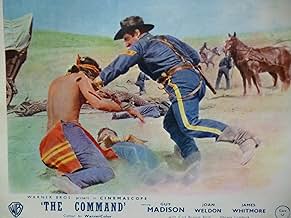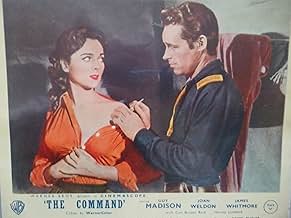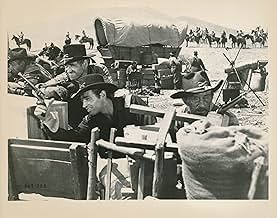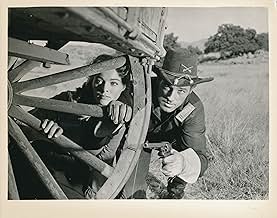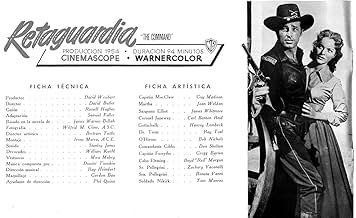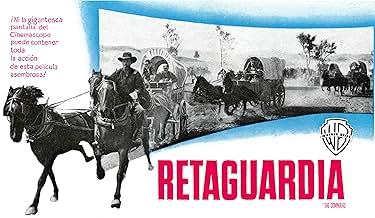AVALIAÇÃO DA IMDb
6,4/10
706
SUA AVALIAÇÃO
Adicionar um enredo no seu idiomaAn Army doctor with no combat experience is forced to take command of a cavalry troop escorting a wagon train through hostile Indian country when the unit's commanding officer dies.An Army doctor with no combat experience is forced to take command of a cavalry troop escorting a wagon train through hostile Indian country when the unit's commanding officer dies.An Army doctor with no combat experience is forced to take command of a cavalry troop escorting a wagon train through hostile Indian country when the unit's commanding officer dies.
- Direção
- Roteiristas
- Artistas
Robert Nichols
- 2nd Lt. O'Hirons
- (as Bob Nichols)
Carl Andre
- Trooper
- (não creditado)
Emile Avery
- Outrider
- (não creditado)
Jim Bannon
- Infantryman
- (não creditado)
Gregg Barton
- Capt. Forsythe
- (não creditado)
George Bell
- Webb
- (não creditado)
John Beradino
- Sergeant Major
- (não creditado)
Richard Boyer
- Infantry Sergeant
- (não creditado)
Larry Chance
- Indian Brave
- (não creditado)
Mack Chandler
- Infantry Lieutenant
- (não creditado)
- Direção
- Roteiristas
- Elenco e equipe completos
- Produção, bilheteria e muito mais no IMDbPro
Avaliações em destaque
When the unit's commanding officer dies , an unexperienced officer doctor (Guy Madison) takes the command a regiment and to lead a wagon train through hostile Indian country . But the Privates believe that experienced Sgt. Elliott (James Withmore) should have been put in temporary command until they reach the Fort . Then , they are ordered by the Colonel in command of a group of infantry to escort a wagon train of settlers (Joan Weldon , among them) moving west . Along the way they must fight off illness , smallpox and rampaging Comanches who are also after them . The Story of the Unconquerable!
Moving and action-packed Western with a simple , standard story that engages the viewer until the last scene , dealing with a cavalry troop escorting a wagon train . An ordinary Cavalry Western in which a officer doctor is saddled with the risked assignment of steering a wagon train through hostile Indian territory . The film packs thrills , noisy action , crossfire , and being enough entertaining . It's a medium budget film with comfortable actors , technicians , functional production values and pleasing results . This was the first Cinemascope Western and the first Scope movie of any kind from Warner Brothers , a studio formerly committed to the 3D process , and not forgetting the Panoramic shots that showed the new process off to its best effect , using Zeiss anamorphic lenses . Decent and pleasant traditional Western with professional direction and flawlessly acted by Guy Madison as Capt. Robert MacClaw , Joan Weldon as Martha Cutting and James Whitmore as Sgt. Elliott . Guy Madison was one of the most popular Western stars at the time , he also performed in the first 3D Western : The charge of Feather River . Guy played leads in a series of programmers before being cast as legendary lawman Wild Bill Hickok in the TV series Adventures of Wild Bill Hickok (1951). Madison had his first major role in "Until the End of Time" a drama directed by Edward Dmytryk, 1946 to then changed in action roles , mainly series B westerns , get some successes with the series . He played Hickok on TV and radio for much of the 1950s, and many of the TV episodes were strung together and released as feature films. Madison managed to squeeze in some more adult-oriented roles during his off-time from the series, but much of this work was also in westerns. After the Hickok series ended Madison found work scarce in the U.S. and traveled to Europe, where he became a popular star of Italian westerns and German adventure films , such as : ¨Duel at Rio Bravo¨ , ¨7 Winchester for a massacre¨ , ¨Bang bang Kid¨, ¨Five for revenge¨ , ¨Il figlio di Django¨ and ¨Reverend Colt¨ . Support cast is pretty well, giving splendidly fortright acting , such as : Carl Benton Reid , Gregg Barton , Harvey Lembeck , Denver Pyle and usual Ray Teal , among others .
It contains an atmospheric and adequate musical score by the classic composer Dimitri Tiomkin . Faded and tarnished cinematography Wilfrid M. Cline with a very bad print , being utterly necessary a perfect remasterizing . Being shot on location in Russell Ranch - Triunfo Canyon Road , Janss Conejo Ranch, Thousand Oaks, Agoura, California, and Warner Ranch, Calabasas, California. This breeze-fresh movie filled with get-up-and-go was professionally directed by David Butler, though drags at times , balancing in ups and downs . Butler was a good craftsman who directed all kinds of genres with special penchant for comedy , musical and drama . As he directed : April in Paris , Tea for two , Playmates , Doubting Thomas , Caught in the draft , The story of Seabiscuit , Lullaby in Broadway , The princess and the pirate , Captain January , The road to Morocco , and Westerns as : San Antonio , Calamity Jane and this The Command . Rating : 5.5/10 . Acceptable and passable .
Moving and action-packed Western with a simple , standard story that engages the viewer until the last scene , dealing with a cavalry troop escorting a wagon train . An ordinary Cavalry Western in which a officer doctor is saddled with the risked assignment of steering a wagon train through hostile Indian territory . The film packs thrills , noisy action , crossfire , and being enough entertaining . It's a medium budget film with comfortable actors , technicians , functional production values and pleasing results . This was the first Cinemascope Western and the first Scope movie of any kind from Warner Brothers , a studio formerly committed to the 3D process , and not forgetting the Panoramic shots that showed the new process off to its best effect , using Zeiss anamorphic lenses . Decent and pleasant traditional Western with professional direction and flawlessly acted by Guy Madison as Capt. Robert MacClaw , Joan Weldon as Martha Cutting and James Whitmore as Sgt. Elliott . Guy Madison was one of the most popular Western stars at the time , he also performed in the first 3D Western : The charge of Feather River . Guy played leads in a series of programmers before being cast as legendary lawman Wild Bill Hickok in the TV series Adventures of Wild Bill Hickok (1951). Madison had his first major role in "Until the End of Time" a drama directed by Edward Dmytryk, 1946 to then changed in action roles , mainly series B westerns , get some successes with the series . He played Hickok on TV and radio for much of the 1950s, and many of the TV episodes were strung together and released as feature films. Madison managed to squeeze in some more adult-oriented roles during his off-time from the series, but much of this work was also in westerns. After the Hickok series ended Madison found work scarce in the U.S. and traveled to Europe, where he became a popular star of Italian westerns and German adventure films , such as : ¨Duel at Rio Bravo¨ , ¨7 Winchester for a massacre¨ , ¨Bang bang Kid¨, ¨Five for revenge¨ , ¨Il figlio di Django¨ and ¨Reverend Colt¨ . Support cast is pretty well, giving splendidly fortright acting , such as : Carl Benton Reid , Gregg Barton , Harvey Lembeck , Denver Pyle and usual Ray Teal , among others .
It contains an atmospheric and adequate musical score by the classic composer Dimitri Tiomkin . Faded and tarnished cinematography Wilfrid M. Cline with a very bad print , being utterly necessary a perfect remasterizing . Being shot on location in Russell Ranch - Triunfo Canyon Road , Janss Conejo Ranch, Thousand Oaks, Agoura, California, and Warner Ranch, Calabasas, California. This breeze-fresh movie filled with get-up-and-go was professionally directed by David Butler, though drags at times , balancing in ups and downs . Butler was a good craftsman who directed all kinds of genres with special penchant for comedy , musical and drama . As he directed : April in Paris , Tea for two , Playmates , Doubting Thomas , Caught in the draft , The story of Seabiscuit , Lullaby in Broadway , The princess and the pirate , Captain January , The road to Morocco , and Westerns as : San Antonio , Calamity Jane and this The Command . Rating : 5.5/10 . Acceptable and passable .
The Command is directed by David Butler and adapted by Samuel Fuller and Russell Hughes from the novel "Rear Guard" written by James Warner Bellah. It stars Guy Madison, James Whitmore, Joan Weldon, Carl Benton Reid and Harvey Lembeck. A CinemaScope production in Warnercolor, music is by Dimitri Tiomkin and cinematography by Wilfred M. Cline.
When the commanding officer of his Cavalry patrol is killed, the army doctor is tasked with taking the reins and leading the men.
It deserves to be better known. Warner Brother's first CinemaScope release and the first Western to be filmed in that widescreen format, The Command is far better than what the routine synopsis suggests it is. For sure the Cavalry versus Indians theme is the steady heartbeat ticking away in the piece, but the writers have inserted other points of worth to expand the level of interest throughout the hour and half running time.
Madison is Captain MacClaw, the Cavalry doctor who is entrusted with command of the troop by his dying superior. The men aren't happy with this, more so when they find themselves involved in a deadly game of cat and mouse with the Indian hordes. Not only that but they are charged with escorting a civilian wagon train to safety, the residents of which may be transporting smallpox! When the troop are joined by an infantry regiment, this only complicates matters because there's no love lost between the two army forces. Where the Indians have a united front, the various tribes fighting as one force, the American military are at odds with each other on tactics and manoeuvres.
Tactics are a big issue in The Command, the story tosses up the argument about doing things by the book or breaking free of code restrictions and throwing caution to the wind. There's also opposing issues on the medical front, two doctors at odds with diagnoses which quite literally could be the end of them all if they can't get it right. Some critics have said Butler's direction is ponderous, but I'd argue strongly that that is not the case. It's true that the first hour involves a lot of talking, squabbling and sarcasm, but the director is juggling many thematic balls in readiness for the grand last third of the piece. Besides, he does insert action scenes along the way, including one blood and thunder sequence that is capped off by a surprising turn of events.
Then that last half hour comes, and it is superb. The tactics issue comes to a head, and everyone wonders if this is going to be another General Custer piece of history. Pic then explodes into all out action, with weaponry combat supplemented by hand to hand sequences. Chases are electrifying, the fires do rage and the wagons do hurtle and fall, the stunt work here is excellent, as is Butler's fluid camera work. We even have time for some fun in the mix, as one of the "special" tactics involves drag artistry. Tiomkin layers a boisterous score over proceedings, mixing marching beats with thunderclap percussion, and Cline in the Scope format brings the various California locations (pic is mostly set outdoors) bursting out of the screen. Cast are just dandy, with Whitmore the class act on show, but both Madison and Weldon make for a colourful and appealingly interesting pair.
It's guilty of being rooted in those Westerns of the era who just put the Indians up as a savage force whooping, hollering, firing arrows and flinging axes. Even though Whitmore's Sergeant Elliot is given some lines that recognise the Indians as not being dumb Howitzer fodder. So this obviously isn't in the league of those great psychological Westerns that afforded the Indians great respect. This is firmly in the realm of action for entertainments sake, with some other delicate thematics that garnish the spectacle on the cinematic plate. 8/10
When the commanding officer of his Cavalry patrol is killed, the army doctor is tasked with taking the reins and leading the men.
It deserves to be better known. Warner Brother's first CinemaScope release and the first Western to be filmed in that widescreen format, The Command is far better than what the routine synopsis suggests it is. For sure the Cavalry versus Indians theme is the steady heartbeat ticking away in the piece, but the writers have inserted other points of worth to expand the level of interest throughout the hour and half running time.
Madison is Captain MacClaw, the Cavalry doctor who is entrusted with command of the troop by his dying superior. The men aren't happy with this, more so when they find themselves involved in a deadly game of cat and mouse with the Indian hordes. Not only that but they are charged with escorting a civilian wagon train to safety, the residents of which may be transporting smallpox! When the troop are joined by an infantry regiment, this only complicates matters because there's no love lost between the two army forces. Where the Indians have a united front, the various tribes fighting as one force, the American military are at odds with each other on tactics and manoeuvres.
Tactics are a big issue in The Command, the story tosses up the argument about doing things by the book or breaking free of code restrictions and throwing caution to the wind. There's also opposing issues on the medical front, two doctors at odds with diagnoses which quite literally could be the end of them all if they can't get it right. Some critics have said Butler's direction is ponderous, but I'd argue strongly that that is not the case. It's true that the first hour involves a lot of talking, squabbling and sarcasm, but the director is juggling many thematic balls in readiness for the grand last third of the piece. Besides, he does insert action scenes along the way, including one blood and thunder sequence that is capped off by a surprising turn of events.
Then that last half hour comes, and it is superb. The tactics issue comes to a head, and everyone wonders if this is going to be another General Custer piece of history. Pic then explodes into all out action, with weaponry combat supplemented by hand to hand sequences. Chases are electrifying, the fires do rage and the wagons do hurtle and fall, the stunt work here is excellent, as is Butler's fluid camera work. We even have time for some fun in the mix, as one of the "special" tactics involves drag artistry. Tiomkin layers a boisterous score over proceedings, mixing marching beats with thunderclap percussion, and Cline in the Scope format brings the various California locations (pic is mostly set outdoors) bursting out of the screen. Cast are just dandy, with Whitmore the class act on show, but both Madison and Weldon make for a colourful and appealingly interesting pair.
It's guilty of being rooted in those Westerns of the era who just put the Indians up as a savage force whooping, hollering, firing arrows and flinging axes. Even though Whitmore's Sergeant Elliot is given some lines that recognise the Indians as not being dumb Howitzer fodder. So this obviously isn't in the league of those great psychological Westerns that afforded the Indians great respect. This is firmly in the realm of action for entertainments sake, with some other delicate thematics that garnish the spectacle on the cinematic plate. 8/10
A great Western that entertains well. It is a movie, along with "Charge at Feather River", where Guy Madison plays a character that though having to fight the Indians, also understands their situation.
The chemistry between Madison's and Whitmore's characters was very well played. It is well paced with story moments and action moments fitting together well.
As a historical note, the Winchesters used by the troopers were incorrect as props but then this was a 1950s Western when no one cared about those details. Spencer Carbines would have been correct but unavailable. The one interesting gun prop is in the scene where the scouts are chased back to the column and meet up with the Capt. and others. One of the troopers is obviously holding a Schofield revolver which though quite unusual, were used by the U.S. Cavalry in small numbers.
I really hope that this movie is released on DVD someday soon.
The chemistry between Madison's and Whitmore's characters was very well played. It is well paced with story moments and action moments fitting together well.
As a historical note, the Winchesters used by the troopers were incorrect as props but then this was a 1950s Western when no one cared about those details. Spencer Carbines would have been correct but unavailable. The one interesting gun prop is in the scene where the scouts are chased back to the column and meet up with the Capt. and others. One of the troopers is obviously holding a Schofield revolver which though quite unusual, were used by the U.S. Cavalry in small numbers.
I really hope that this movie is released on DVD someday soon.
After Captain Gregg Barton has been killed before dying he placed his troop of cavalry in the hands of the only officer left, army doctor Guy Madison. Madison is bringing them back to their fort when they meet up with a company of infantry and the wagon train they're escorting through Indian country. The short tempered Colonel Don Shelton, commandeers that same cavalry to help with the escort without knowing that Madison has no military training. The rest of the cavalrymen keep Madison's real army specialty a secret lest they spread some panic among the settlers.
Of course The Command that Madison is stuck with is no milk run. He's got to learn some real military tactics and has to learn them fast. Among the settlers there is an outbreak of what could be smallpox and Madison is hamstrung in giving aid in the profession he is trained in. Out of necessity he has to tell Joan Weldon who is traveling with the wagon train in the wagon where the sickness is starting.
The Command was one of the first film's done in the wide screen process with some 3D thrown in for good measure. With films on the big screen competing with the free small screen, gimmicks were thought to be needed to get the public out of their living rooms. A good solid cavalry western which The Command is was not enough at times.
James Whitmore as the sergeant who by rights should have been in charge and wisecracking Harvey Lembeck stand out in this cast. With a doctor hero and a cavalry setting, I'm surprised John Ford wasn't brought in for The Command. It seems like just his kind of material.
Of course The Command that Madison is stuck with is no milk run. He's got to learn some real military tactics and has to learn them fast. Among the settlers there is an outbreak of what could be smallpox and Madison is hamstrung in giving aid in the profession he is trained in. Out of necessity he has to tell Joan Weldon who is traveling with the wagon train in the wagon where the sickness is starting.
The Command was one of the first film's done in the wide screen process with some 3D thrown in for good measure. With films on the big screen competing with the free small screen, gimmicks were thought to be needed to get the public out of their living rooms. A good solid cavalry western which The Command is was not enough at times.
James Whitmore as the sergeant who by rights should have been in charge and wisecracking Harvey Lembeck stand out in this cast. With a doctor hero and a cavalry setting, I'm surprised John Ford wasn't brought in for The Command. It seems like just his kind of material.
10segstef
The good thing about this movie is the sympathy toward Native Americans. The Native Americans had no immunity to smallpox or chicken pox and no medicine to treat diseases. The main character played by Guy Madison constantly showed concern toward the Native Americans although he had to fight them. Although this movie had this social issue,it still had all the rousing entertainment of most calvary movies. The movie had a lot of saluting, which sometimes became a distraction. James Whitmore was great as the seasoned veteran just as he was in "Battleground". This movie had me wanting both sides to win.
Você sabia?
- CuriosidadesAt about 79 minutes, in a scene of Indians attacking the wagons full of soldiers, one Indian gets shot off his horse, then is run over by a wagon drawn by four horses . That wasn't a planned stunt--he was supposed to be "shot" and fall off the side of his horse, but the horse unexpectedly reared back and dumped him into the path of the wagon, which ran over him. He suffered numerous broken bones and ribs, but the scene was left in.
- Erros de gravaçãoIn 1876 the single-shot Springfield Model 45-70 1873 rifle was the standard US Army infantry rifle, as identified by Captain MacClaw when he picks up an abandoned one. The cavalry used a single-shot carbine version of the Springfield 1873. Yet the final battle sequences show both the infantry and the cavalry troopers exclusively using Winchester or Henry style lever action repeating rifles, even though these weapons were never Army issue.
- Citações
Sgt. Elliott: Never say an Injun is dumb. He just waits for the chance to use his one good cavalry tactic: ring around and close in.
- ConexõesReferenced in Com o Céu no Coração (1954)
Principais escolhas
Faça login para avaliar e ver a lista de recomendações personalizadas
- How long is The Command?Fornecido pela Alexa
Detalhes
- Data de lançamento
- País de origem
- Idiomas
- Também conhecido como
- Retaguardia
- Locações de filme
- Empresa de produção
- Consulte mais créditos da empresa na IMDbPro
Bilheteria
- Faturamento bruto nos EUA e Canadá
- US$ 2.500.000
- Tempo de duração
- 1 h 34 min(94 min)
Contribua para esta página
Sugerir uma alteração ou adicionar conteúdo ausente

